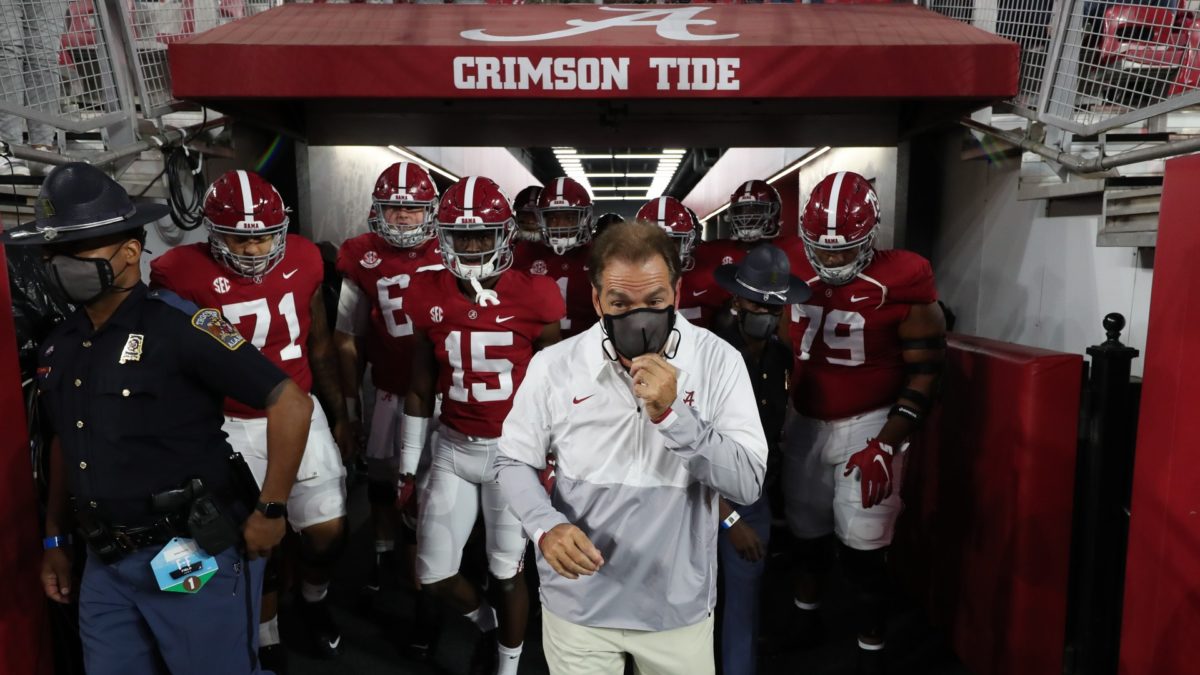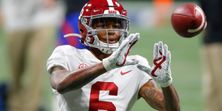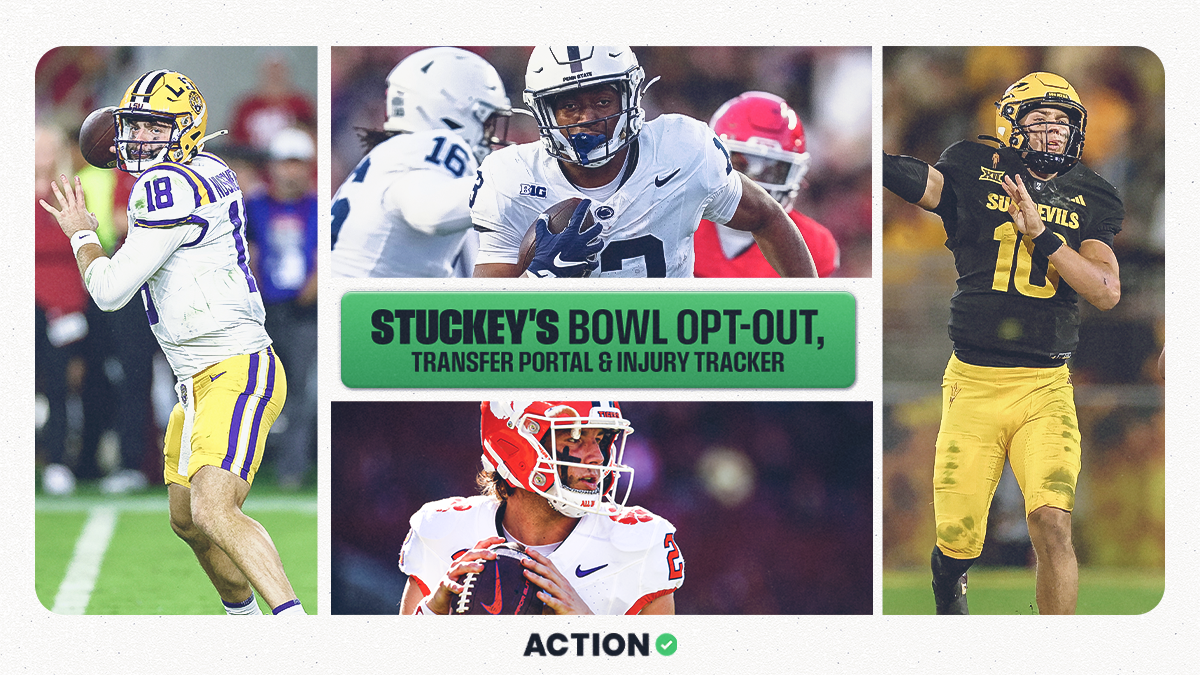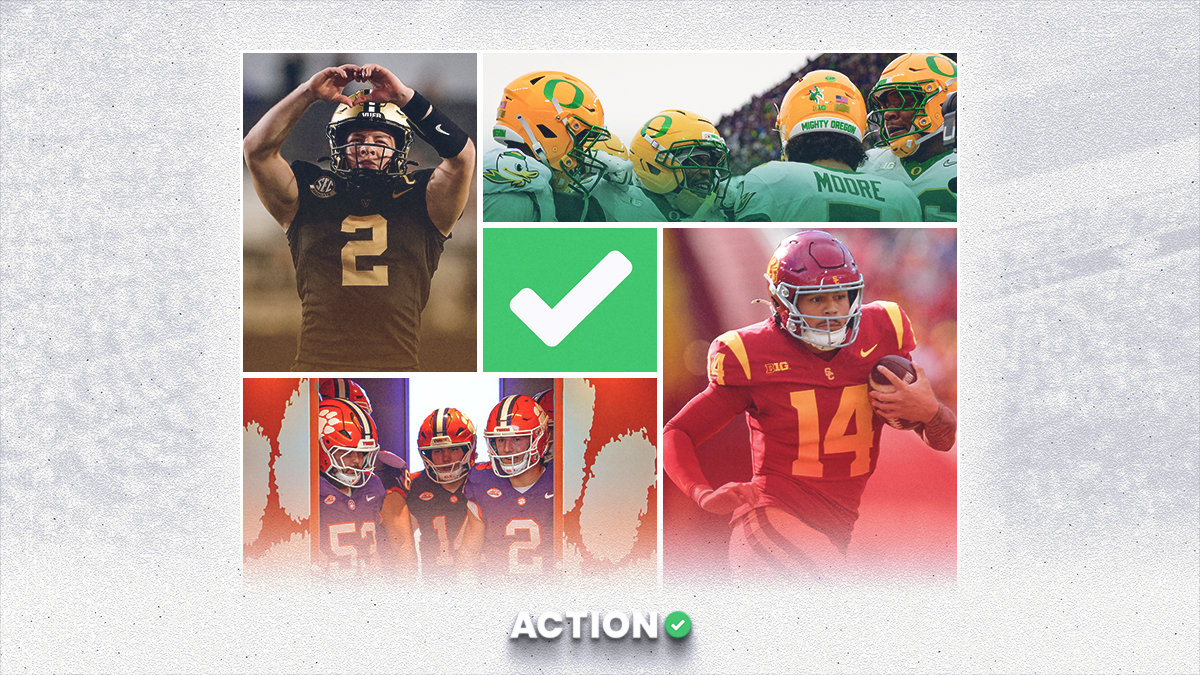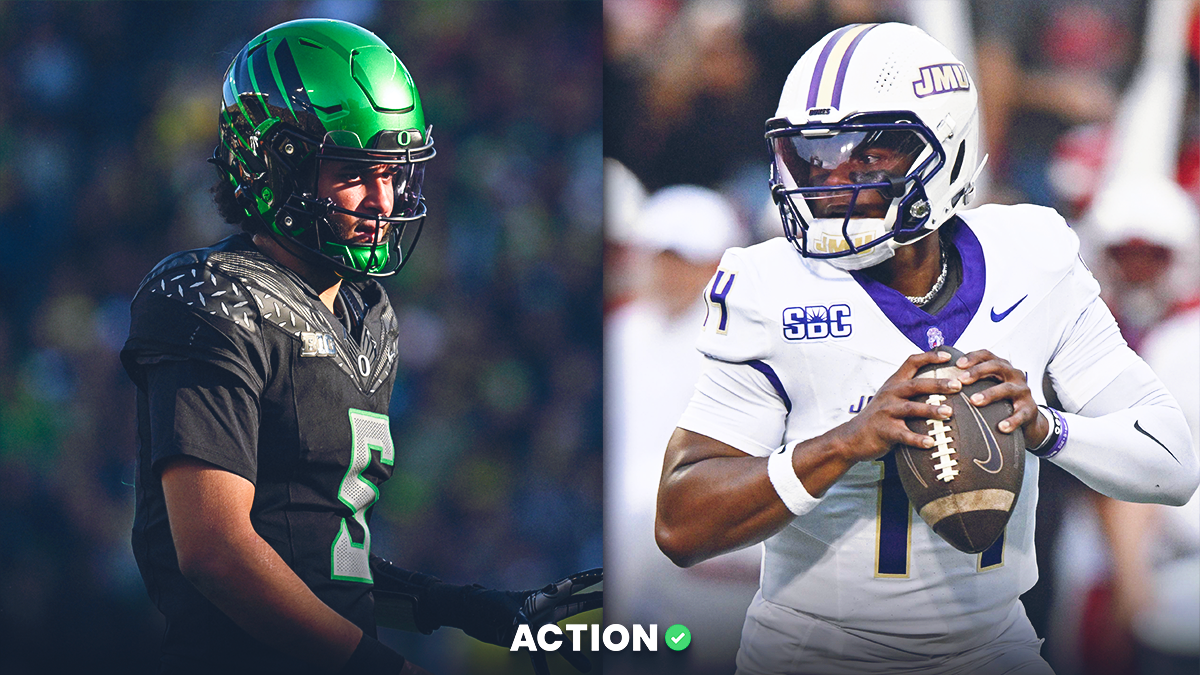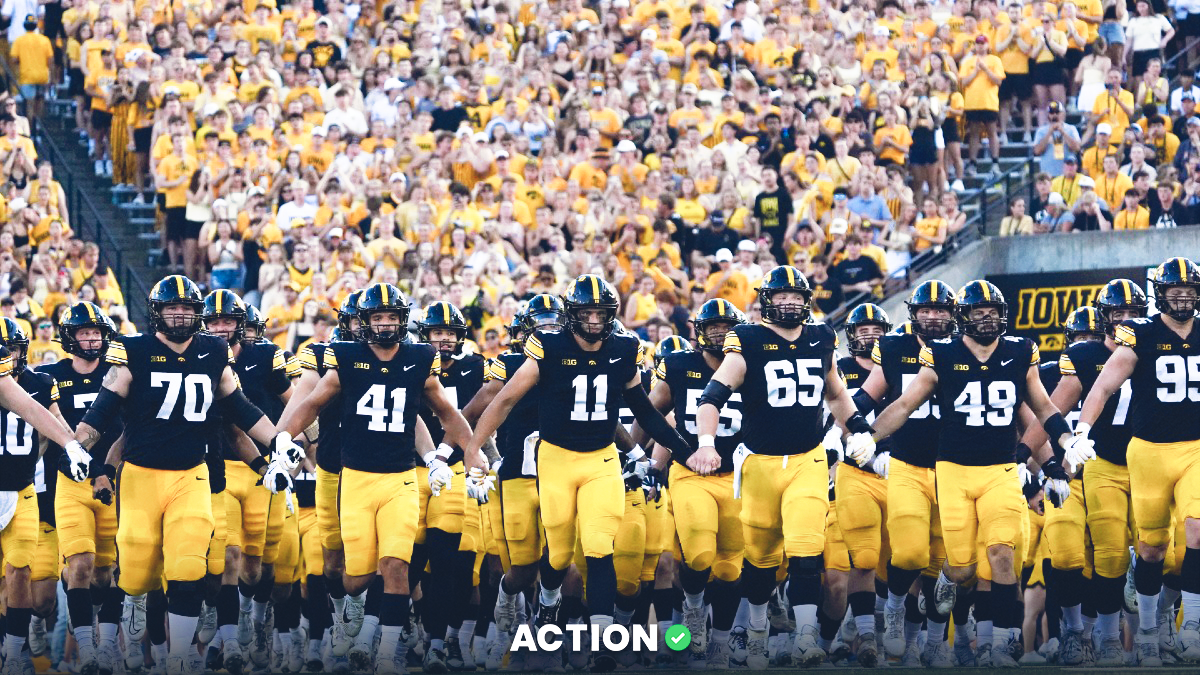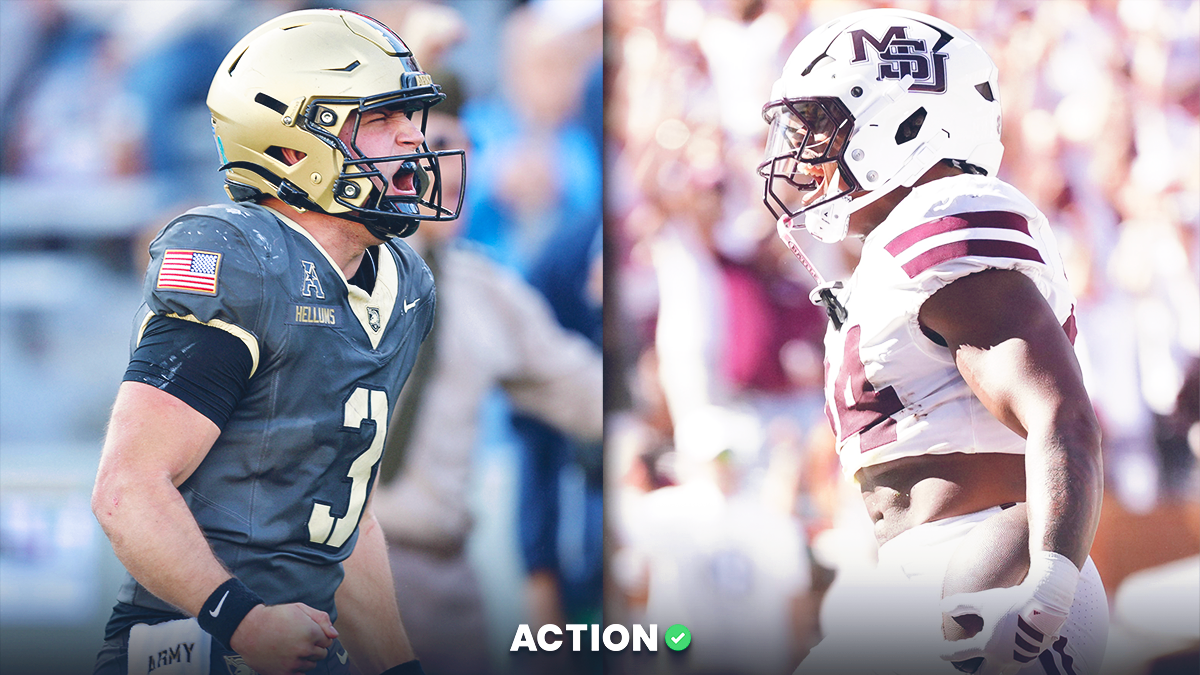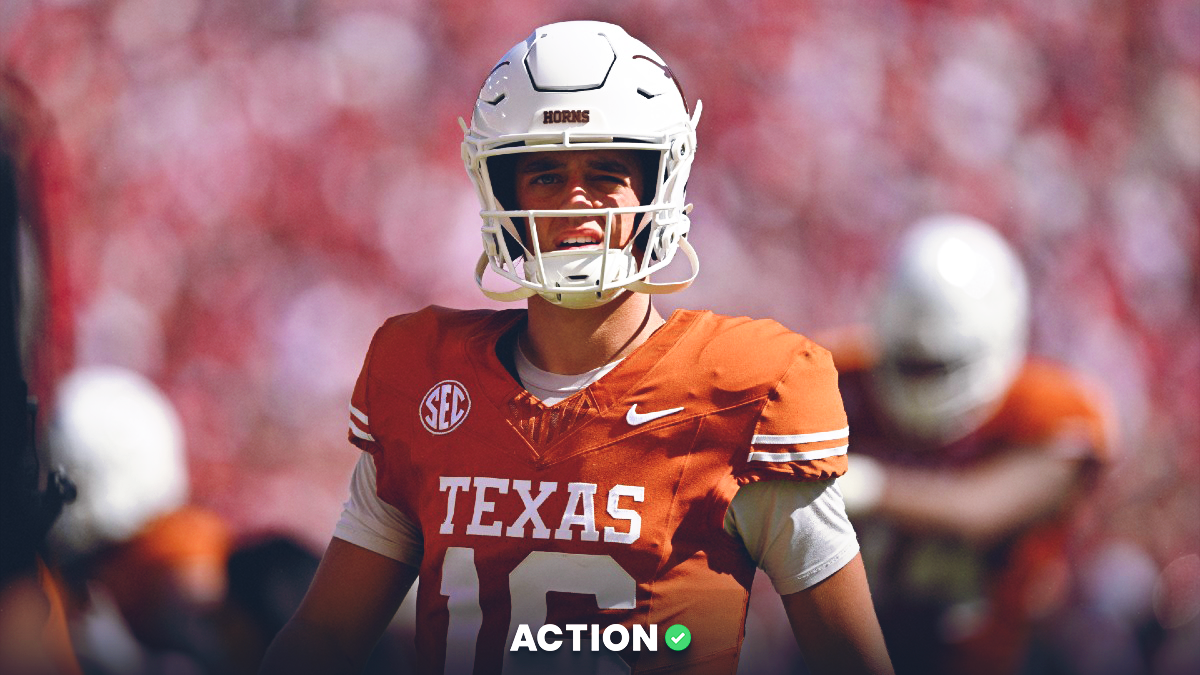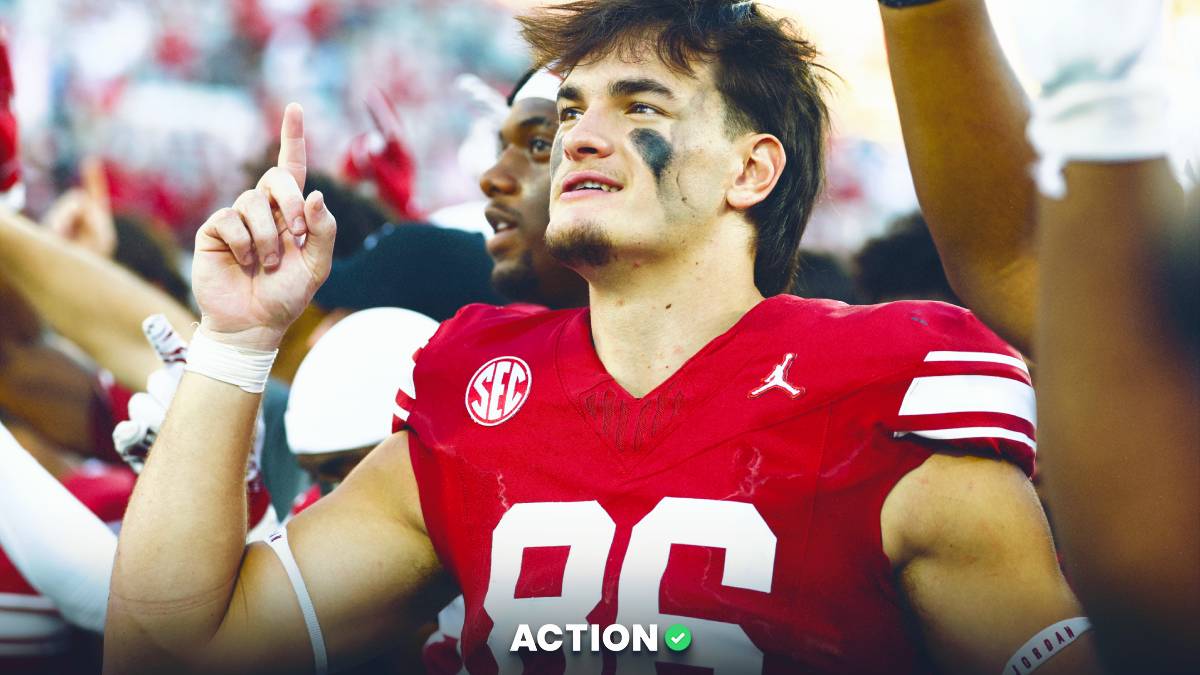- Ohio State and Alabama both entered the National Championship following impressive performances over Clemson and Notre Dame, respectively.
- Those Sugar Bowl and Rose Bowl performances both translate to the National Championship game, and that's why Darin Gardner shared his favorite prop bets for the game.
- Check out each of Gardner's picks complete with a section of betting analysis below.
Ohio State vs. Alabama Odds
This should be a National Championship game with plenty of excitement, as it pits the two highest-scoring offenses in Power Five football against one another.
The Buckeyes are riding high after rolling Clemson despite being a touchdown underdog, while the Crimson Tide handled business as usual in their semifinal matchup.
I want to take a game-by-game angle to analyze each team and how they stack up to each another. This is a really unique championship game because the sample size for Ohio State is much smaller than we have ever seen in the College Football Playoff era from a championship participant.
Game-By-Game Performance
These two charts below compare each team's season-long performances from each game, both from an Expected Points Added per play perspective as well as Success Rate. Garbage time is also filtered out to give a better understanding of each team's true performance.
For those who are new to these metrics, Expected Points Added (EPA) puts a value on each play based on down, distance, and field position, relative to what the expectation would be on that specific play.
For example, an 18-yard gain from the opponent's 20-yard line would result in a higher EPA than an 18-yard gain from a team's own 30. Basically, it measures the value a team provides over expectation on any given play.
Success Rate is more straightforward. A play is marked as "successful" if it gains at least 50% of the yards needed to the marker on first down, 70% to the first down marker on second down, and 100% on third and fourth down (per College Football Data). These are two of my favorite metrics for measuring team efficiency.
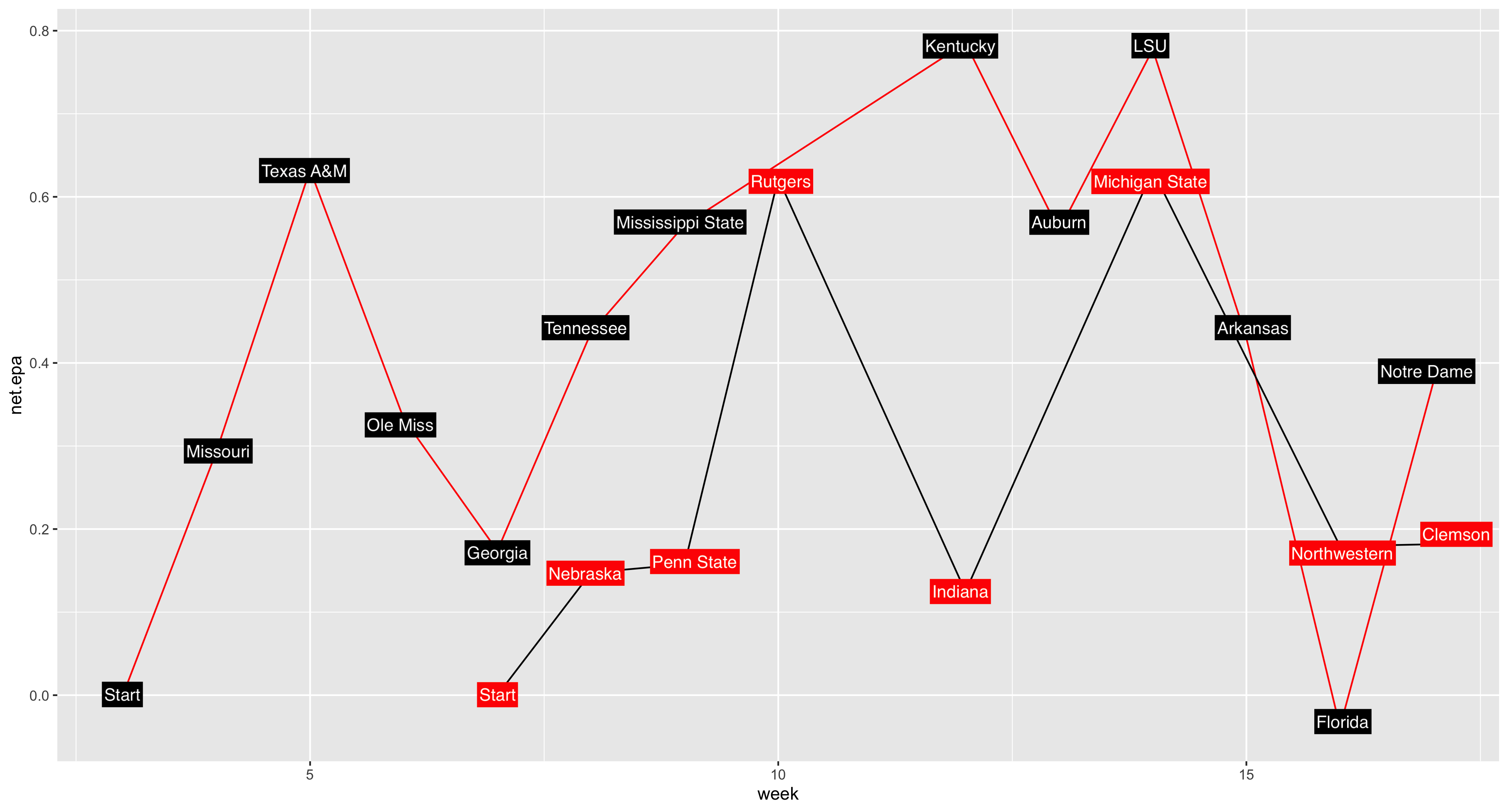
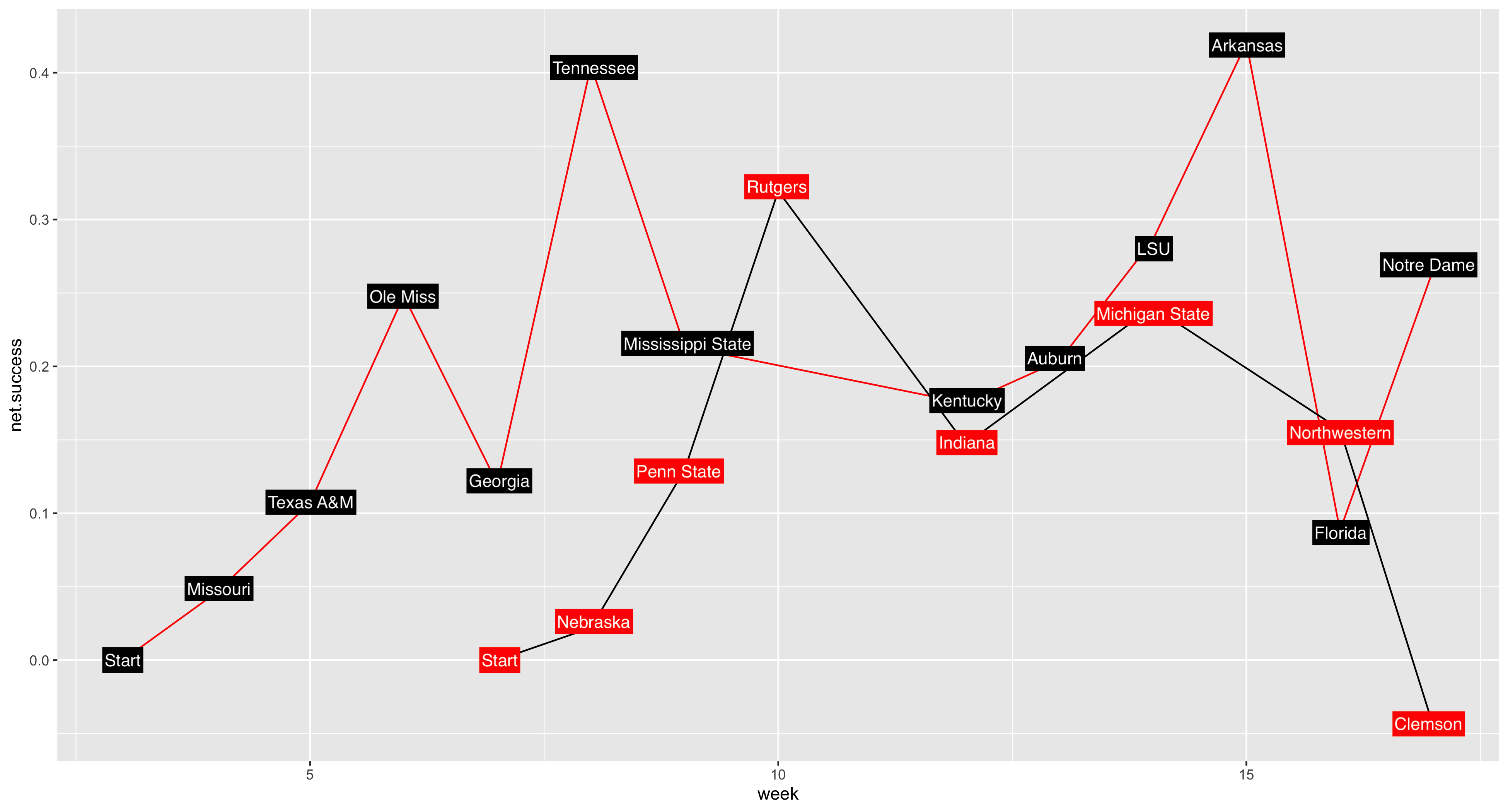
In terms of EPA, Alabama was clearly the most dominant team despite playing a tougher schedule than the Buckeyes. If you look at the most dominant games by each team combined, Alabama had 10 of the 12 most dominant performances between the two based on net EPA.
Ohio State had three of the bottom four. The Buckeyes had two dominant performances against Rutgers and Michigan State, but they did not bury their opponents like the Tide.
One interesting note from the chart, however, is that Alabama had the only game between the two with a negative net EPA. Despite beating Florida in the SEC Championship, Alabama actually posted a lower EPA per play than the Gators and finished the game with a -0.03 net EPA.
When looking at net Success Rate, Alabama had a clear lead as well. It had four of the five most dominant performances in that department and seven of the top nine.
No matter how you look at it, the Tide did a much better job of dominating their opponents than the Buckeyes.
How Did Each Team Fare In Its Toughest Test?
Ohio State Buckeyes
A lot of the narrative around Ohio State leading into the Clemson game was that the Buckeyes had not faced any elite opponents up to that point due to a shortened schedule and a mostly down year for the rest of the Big Ten.
Ohio State obviously put those doubts to bed after throttling the Tigers. What can we take from that game that will give us an idea of how this matchup will play out for the Buckeyes?
The main takeaway from Ohio State's dominant win was its offensive explosiveness. Although each team posted high Success Rates, one picked up huge chunks while the other did not.
The Buckeyes hit big plays at will against what we thought was an elite Clemson defense.
On its first 10 drives, Ohio State hit a gain of at least 25 yards on seven of them for eight in total. Six came through the air, while running back Trey Sermon added gains of 32 and 30 yards on the ground.
Through the air, the Buckeyes hit plays of 56, 47, 45, 36, 34, and 26 yards all within their first 10 drives. They had three different receivers who averaged at least 20 yards per catch.
While the Buckeyes dominated in every phase on offense, their defensive performance did not really answer any of the major questions we had about them on that side of the ball. Instead, they dominated where we knew they were strong — run defense — but really struggled in one particular area.
The Buckeyes have really struggled in coverage on the outside this year, and Clemson exploited that weakness by putting Cornell Powell up against Shaun Wade.
Trevor Lawrence targeted 12 times as the receiver caught eight passes for 139 yards and two touchdowns.
Although Ohio State had faced a weak schedule of opposing pass offenses beforehand, it had still been exploited previously.
This performance against Clemson just provided more evidence that the Buckeyes simply cannot hang with elite receivers. Spoiler alert: Alabama has a receiver who has won a few one-on-one matchups this year.
Alabama Crimson Tide
I'm going to do a deep dive into Alabama's performance in the SEC Championship game rather than the playoff for a few reasons.
For one, Florida is much more similar to Ohio State in the fact that it has an elite offense combined with an exploitable defense. It's capable of putting up points in bunches, while Notre Dame just isn't.
I feel that the Florida game will have more similarities to how this National Championship game will play out rather than the Notre Dame game. The Irish never had an offense that was going to keep it competitive with Alabama.
To start, each team had 10 "true" drives in the game. Alabama scored a touchdown on all five of its first-half drives and put up seven in its 10 total drives.
Florida made sure to limit explosive plays at all costs, keep everything in front of it, and force Alabama to embark on long drives. Unfortunately for the Gators, that's exactly what Alabama did. A 56% Success Rate for the Tide was more than enough to offset the lack of one-minute touchdown drives that we have gotten accustomed to from them.
On the other side of the ball, Florida found plenty of success against Alabama's defense with tight end Kyle Pitts and receiver Kadarius Toney. The two combined for 15 catches on 20 targets for 282 yards and one touchdown each.
What sticks out about those two performances? Both Pitts and Toney do most of their work in the middle of the field. Toney plays primarily in the slot, with 506 snaps inside compared to just 80 out wide. Pitts has seen 83% of his offensive snaps lined up either in-line or in the slot.
Another interesting wrinkle to this is that Ole Miss also found plenty of success against the Alabama defense, and it did so in similar ways.
Just like Florida, Ole Miss found success in the middle of the field with its tight end and slot receiver. Tight end Kenny Yeboah put up 183 receiving yards against the Tide, and slot receiver Elijah Moore had 143 yards.
Alabama's defense is hard to crack, but there's a clear blueprint to finding success against it. This chart below shows just how much better Florida and Ole Miss were against this defense than any of Alabama's other opponents.

The Matchup
Ohio State's Offense vs. Alabama's Defense
Florida and Ole Miss laid out the blueprint for how to attack this Alabama defense: exploit its passing defense in the middle of the field.
Alabama has an incredible trio of cornerbacks in Patrick Surtain, Josh Jobe, and Malachi Moore in the slot. Surtain is the highest-graded corner in the nation, per Pro Football Focus, and is a future top-10 pick, while Moore ranks 19th in PFF grade and Jobe 31st.
For much of the year, safety Daniel Wright was an exploitable matchup that went against Alabama, as he holds a 52.2 PFF coverage grade through 587 snaps.
However, it seems as though Wright has found his way to the bench. He played only 25 snaps against Notre Dame, with sophomore DeMarcco Hellams taking his place.
He has performed much better than Wright in coverage through 388 snaps. Although Wright struggled in coverage, he was not the biggest liability in that department on the team.
Alabama plays primarily in nickel (five DBs, two linebackers), but its two starting linebackers have really struggled all season long. That's where Alabama is most vulnerable in coverage. Linebackers Dylan Moses and Christian Harris own coverage grades of 61.3 and 54.3, respectively.
Florida and Ole Miss found ways to attack those backers in the passing game while avoiding the corners on the outside.
The strength of Ohio State's passing game is its top two wide receivers: Chris Olave and Garrett Wilson.
Those two have accounted for 70% of Ohio State's passing yards. Wilson fits the Kadarius Toney/Elijah Moore mold to some degree, as most of his snaps have come in the slot.
To fully exploit Alabama's weakness in the passing game, the Buckeyes will need to get some production from tight ends Jeremy Ruckert and Luke Farrell.
The two have accounted for only 152 yards, but Ruckert proved he could be a weapon in the Clemson game. He gained 55 yards and added two touchdowns on the Tigers. Ohio State will need more of that to keep pace.
In the running game, the Buckeyes' ground attack will easily be the best that Alabama will face this season. Alabama's run defense has limited Rushing Success Rate, holding all but two of its opponents under their season average. The unit currently ranks 20th in Rushing Success Rate allowed.
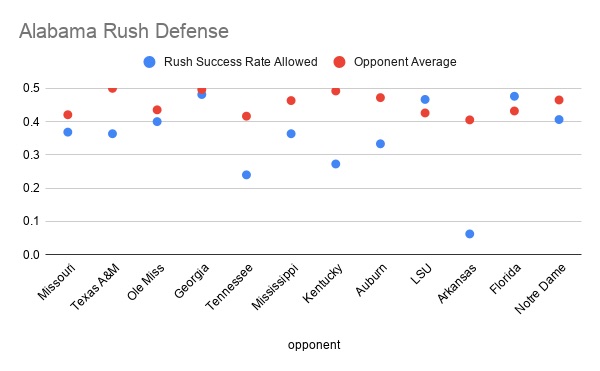
It has also been effective in limiting rush explosiveness. The Tide rank 19th in limiting runs of 10+ yards (10.2% of opponent's carries) and 24th in limiting runs of 20+ yards (2.7%).
However, Clemson went into the playoff semifinal game with a rush defense that ranked in the top five in many of the important categories.
Ohio State's offensive line, which ranks in the top 10 in Line Yards, Opportunity Rate, and Stuff Rate, clearly won the matchup against an elite Clemson front.
If Sermon racked up 199 rushing yards on 6.4 yards per carry against the Tigers, he has a good chance to be able to find plenty of success on the ground against Alabama.
Ohio State will probably find ways to be efficient in the running game, which could help limit Alabama's possessions. However, to keep this game tight until the end, the Buckeyes will need to find a way to pick up chunks through the air.
Alabama's Offense vs. Ohio State's Defense
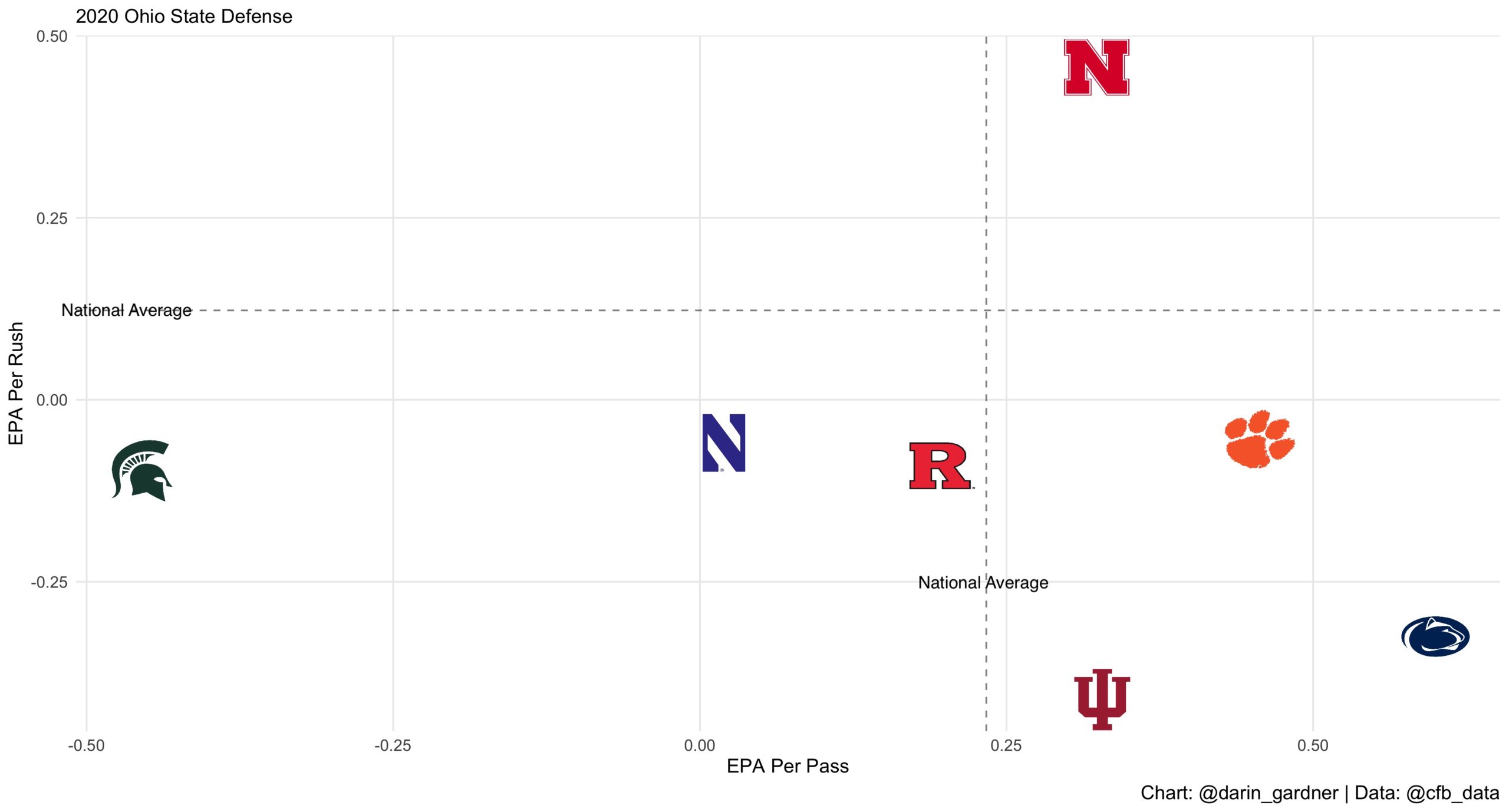
Simply put, Ohio State just is not equipped to slow down this Alabama passing attack.
The only teams that Ohio State has held below the national average for EPA per pass were Michigan State, Northwestern, and Rutgers (barely). Despite playing a seven-game schedule that included three terrible passing offenses, the Buckeyes still rank 67th in opponent yards per attempt and 68th in explosive pass rate allowed (10% of opponent attempts).

When you look at Alabama's passing game, it really doesn't matter who the defense has been. It has blown away almost every defense it has faced, as you can see in the chart above.
In all of its games, it created significantly more Expected Points Added per pass than its opponent had allowed on average. There are only seven offenses generating at least 0.5 EPA per pass on offense, and Alabama has done that in every single game aside from Mississippi State and Arkansas.
Wade is now the Buckeyes' top corner after two departures last year, and he has struggled tremendously against true No. 1 receivers. Wade has allowed over 100 yards on his targets in three of the team's seven games, and all three of those games were against offenses with legit No. 1 receivers.
Indiana's Ty Fryfogle hit the Buckeyes with a seven-catch, 223-yard, three-touchdown performance, and Penn State's Jahan Dotson racked up eight catches for 144 yards and three scores.
In the playoff semifinal game, Powell was targeted twelve times, catching eight for 139 yards and two touchdowns Against the only three receivers it faced that can truly be asked to win one-on-one matchups on the outside, Ohio State allowed a total of 23 catches, 506 yards, and eight touchdowns in just three games to those receivers.
There's no reason to think DeVonta Smith won't feast against the Buckeyes, and if Jaylen Waddle comes back for Alabama, it could get very ugly for this secondary.
While Ohio State will likely struggle against Alabama's passing attack, it could do a reasonable job limiting the Tide on the ground.
The Buckeyes rank second nationally in EPA allowed per rush and are coming off a performance against Clemson in which they allowed just two yards per carry. However, this will be a much bigger test than what the Buckeyes have seen thus far.
To date, the defense has not seen any offense that ranks inside the top 50 in EPA generated per rush. This will definitely be a battle of two heavyweights in the trenches, and it will be interesting to see whether or not the Buckeyes can hold up against a major upgrade in competition.
Ohio State Rush Defense
Alabama Rush Offense vs. Ohio State Rush Defense
Betting Picks
DeVonta Smith Over 134.5 Receiving Yards
Look, I know every single college football fan is going to be on this over. I still think there's value on it.
Smith's receiving yards prop was in the 160s for both the Florida game and the Notre Dame game. Now it's at 134.5? If Waddle does come back, he probably will eat into Smith's production to some degree. But are we expecting him to have a big role here? I can't see it.
As previously mentioned, Ohio State has allowed an average of 169 yards per game to the three No. 1 receivers it has faced this year, and Wade specifically has allowed over 100 yards in all of those games. Wade is going to be the primary coverage defender on Smith in this game.
Smith averages 136.8 receiving yards per game this season and has averaged 155 per game since Waddle's injury.
He also has really stepped up when the opposing offense has been able to keep it close and force Alabama to keep throwing rather than just run the clock out. He caught 13-of-15 targets against Ole Miss for 164 yards and totaled 15 catches on 18 targets for 184 yards against Florida.
The Buckeyes should be able to put up their fair share of points, which should lead to a very healthy amount of targets for Smith in an advantageous matchup against the Buckeye secondary.
Trey Sermon Over 99.5 Rushing Yards
Sermon was splitting carries with Master Teague through the first few games of the season but has amassed 60 total carries in his past two games.
In those games, he totaled 524 yards on 8.7 yards per carry. That also included a game against Clemson's rush defense, which ranks sixth in the country in EPA allowed per rush. On the season, he's averaging 7.5 yards per carry.
I think Sermon will continue to see high usage in this game, as the Buckeyes will probably look to run the ball early to keep Alabama's offense off the field for as long as possible.
Garrett Wilson Over 70.5 Receiving Yards
The two offenses that found a lot of success against Alabama were Florida and Ole Miss with its tight ends and slot receivers.
Florida slot receiver Toney hit the Tide with 158 receiving yards, and Ole Miss' Moore got to 143.
Even if that wasn't the case, I would still like this over.
Wilson's average receiving yards per game is 95.84, and the median is 104. I expect Ryan Day to be able to get Wilson in exploitable matchups in the middle of the field.
Chris Olave Under 95.5 Receiving Yards
Olave will be seeing a lot of Surtain in coverage, and that's as tough a matchup as any receiver can draw in college football.
Surtain is currently the highest-graded cornerback in the country, per PFF. Alabama is vulnerable in the middle but has been incredible against outside receivers like Olave.
It held Auburn's Seth Williams to just 17 yards, Arkansas' Treylon Burks to 16 yards, Notre Dame's Javon McKinley to 20 yards, and Georgia's George Pickens to 53 yards.
All four of those players are their team's top receiving options. Every time they faced an alpha on the outside, Surtain and the Tide's defense have completely shut them down.
WR Receiving Yards vs. Alabama
Mac Jones Under 3.5 Passing Touchdowns +145
This is definitely a "hold your nose" play, but I don't think the under should be +140 on this one. Jones is averaging exactly three touchdowns per game on the year, and we're getting +140 on the under at 3.5. I just think this line is a little too inflated.


